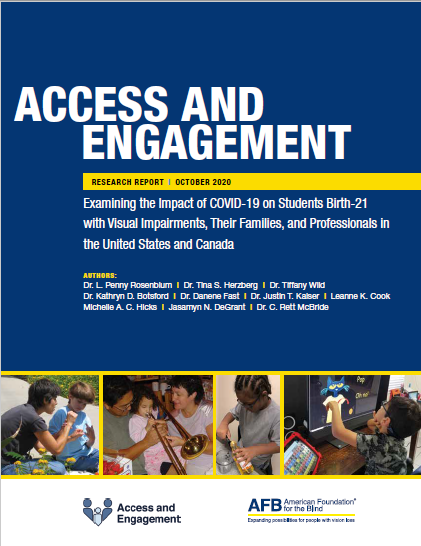AFB has conducted studies that examined how the COVID-19 pandemic specifically affected people who are blind or have low vision. These insights are being shared with the appropriate officials but also highlighted long-standing barriers to accessibility and inclusion. The findings are being shared with the appropriate officials and leaders that can push for systemic changes to create more inclusive environments.
Access and Engagement
The Access and Engagement Study began exploring the impact of COVID-19 on students who are blind or have low vision, their families, and educators in spring 2020, with results issued in a series of reports, with the third and final report issued in June 2022. Among the key findings of the third report were that many digital platforms were not fully accessible or usable.
Lack of reliable internet access was another barrier for some families. According to parents and educators, some subjects—such as Orientation and Mobility (O&M)—were difficult to teach online,
and many students didn’t have a chance to receive in-person services or skill-building experience, which meant lost learning opportunities. The findings also revealed that the pandemic amplified pre-existing inequities, which will continue as inaccessible technology such as online learning platforms remain in use. Learn more about all three reports: afb.org/covid-education-research.
Download the AE one (PDF)Download the AE Two (PDF)Download the AE Three (PDF)
Journey Forward
Our Journey Forward report issued in April 2022, confirmed that Americans who are blind or have low vision have had their lives affected by COVID-19 in ways that demonstrate a clear inequity compared to their sighted counterparts. Even as restrictions were being lifted, people still had challenges in areas such as transportation and telehealth, both of which aren’t going to improve without the significant systems change, because the issues existed before COVID. In fact, transportation access was a factor in every area where people who have low vision faced challenges during the pandemic, along with the lack of digital inclusion.
For example, the survey data showed that many websites and apps used to schedule appointments, order groceries, or even find data about local COVID rates were inaccessible with many types of screen readers and screen enlargement software. That means even having essential items delivered was an issue, especially for some older adults who reported having limited experience with technology. Many people were forced to rely on others to schedule vaccine appointments and help them navigate other issues, but not everyone has someone to assist them. Additional key findings in the report include issues with inaccessible prescription labels and concerns about being able to monitor safety such as physical distancing and mask-wearing by others. Learn more: afb.org/journeyforward
Read on to learn about the work that drove the most impact in 2022.
